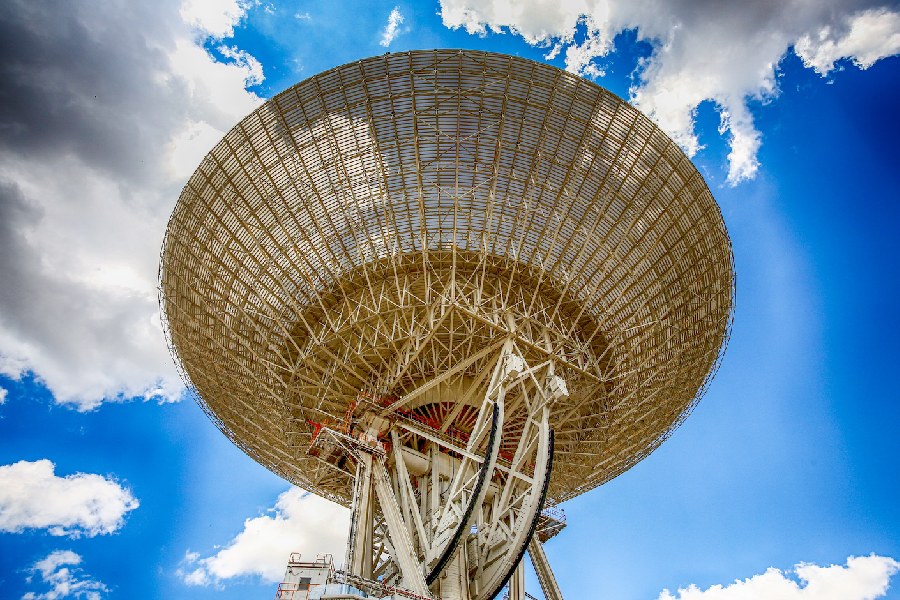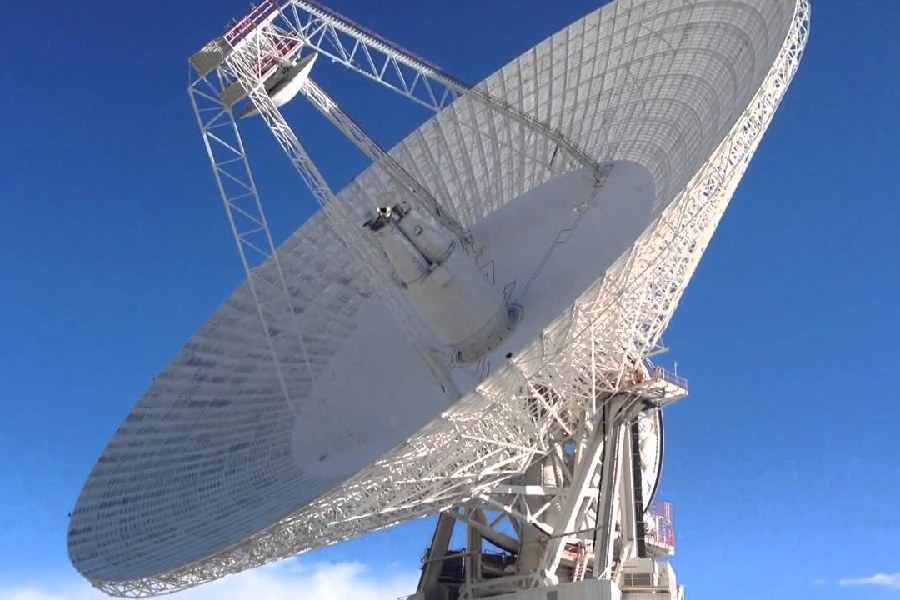Have you ever wondered how spacecraft traveling billions of miles through space are able to communicate with Earth? The answer lies in NASA’s Deep Space Network, an array of massive radio antennas spanning the globe. How does DSN work?
The Deep Space Network allows us to stay in contact with missions throughout our solar system and beyond. Precisely pointed antennas track spacecraft as the Earth rotates, capturing their faint signals even from distances like Mars or Saturn.
In this article, we’ll explore how the Deep Space Network enables distant spacecraft to communicate with home. We’ll look at the strategic locations of the antenna sites around the world.
We’ll also examine the advanced technologies that allow these sensitive radio telescopes to detect tiny signals from spacecraft lightyears away. By the end, you’ll understand how this network of giant dishes makes our journeys into deep space possible.
How Does DSN Work?
The Deep Space Network (DSN), owned by NASA, is a global system of ground-based antennas designed to communicate with and track spacecraft exploring the solar system and beyond.
Strategically located in California, Spain, and Australia, these antennas receive and transmit signals, enabling continuous monitoring and control of deep space missions.
The DSN plays a pivotal role in facilitating two-way communication, data retrieval, and command transmission between Earth and spacecraft, supporting scientific discovery and exploration efforts.
More than a communication link, the DSN is a cosmic cartographer, mapping trajectories and locations, directing humanity’s exploration of the cosmic stage with precision and finesse. The DSN supports interplanetary spacecraft missions.

How is it different from other networks?
Now that you have learned how does DSN work, you need to know how it differs from other networks. The DSN differs from other networks like the Near Earth Network. The DSN is used for communicating with probes and satellites beyond the Moon’s orbit, while other networks connect with satellites closer to Earth.
The main role of the DSN is to allow communication between probes in deep space and controllers back on Earth. This lets scientists obtain data from distant missions.
Operations of the DSN
Signal transmission
The DSN transmits signals to spacecraft using its large antennas. These signals send commands and data to probes lightyears away. The antennas use high frequencies that can travel long distances.
Signal reception
The DSN also receives weak signals from distant probes. The antennas are very sensitive. They can detect faint transmissions from probes billions of miles away. These signals relay data and telemetry back to Earth.
Overcoming long distances
Special technologies are needed to connect over vast cosmic distances. Frequency, power, and antenna size help extend the reach of communications. Signal processing removes noise and interference.
Tracking spacecraft
Pointing antennas precisely
The DSN uses azimuth and elevation rotors to aim antennas. It points them very accurately to keep them “locked” onto spacecraft positions. This precision tracking is needed to maintain contact. Further upgrades will enable sub-millimeter accuracy in pointing giant dish antennas toward distant probes.
Monitoring trajectory and orientation
Besides position, the DSN also monitors spacecraft orientation and trajectory. This ensures antennas stay aligned with probes as they move and rotate. It provides important navigation data. Sensors help detect spin rates, vibration modes, and velocity changes requiring adjustment.
Supporting multiple missions
The DSN concurrently supports multiple spacecraft across the solar system. Careful scheduling and positioning are needed to connect with many probes simultaneously. Shared resources are allocated by priority with consideration of available visibility windows and science returns.
Structure and Components of the DSN
Ground stations
The DSN has ground stations in California, Spain, and Australia. They are spaced equally apart around Earth, allowing constant observation of space as Earth rotates.
The ground stations house large dish antennas. They also contain transmitters, receivers, and data processing systems. Each station can track multiple spacecraft simultaneously.
The ground stations send commands, track positions, and receive data. They relay information between mission control and distant probes. Data flows continuously through the network.
Antennas
The DSN uses many antennas of different sizes. The largest are 70-meter-wide dishes. It also uses smaller 34-meter and 27-meter antennas. In total, there are over 30 antennas in the network.
Different types of antennas serve distinct roles. The largest dishes provide maximum sensitivity and range. Smaller ones are more maneuverable and can track fast-moving objects.
The giant dish antennas enable two-way communication with spacecraft distant billions of miles. Their size and precision aim allow faint signals to be transmitted and received.
Control centers
Mission operations
Engineers in control centers direct operations across the DSN. They schedule communication sessions and antenna allocations for each mission. Commands are sent to spacecraft from here.
Control centers also process huge amounts of data downlinked from space probes. This includes images, instrument readings, and spacecraft status data that are further analyzed.
In control rooms, the performance and status of the entire DSN is continuously monitored. Any technical issues across the global network can be identified and addressed.

Types of Radio Tracking Stations Used in the DSN
70-Meter antennas
- Large dishes– the 70-meter antennas are the DSN’s largest dishes – four in total, located around the world. With diameters spanning over 200 feet, these giant parabolic dishes have extremely high signal sensitivity. These giant parabolic dish antennas collect and focus faint signals into concentrated beams. Only a handful exist at this immense scale.
- Faraway missions– the main use of 70-meter antennas is tracking missions beyond the Moon. Their size enables communicating at huge distances. Specifically suited for transmitting commands and data critical for outer planet missions like Voyager and Cassini at Saturn. Enables both uplink and downlink even billions of kilometers away.
- Critical role– these giant antennas play a critical role. Their capabilities are essential for missions venturing deeper into space. With increasing interest in ice giants and the Kuiper Belt, demand grows for extremely large antennas. 70-meter dishes remain critical infrastructure for solar system frontier exploration.
Giant radio antennas
- Track distant probes–the DSN uses many giant radio antennas to track probes in deep space. Their large size is needed to detect faint signals.
- Precision aim– their tracking must be very accurate. This keeps probes precisely targeted across vast distances. Even tiny errors could lose the signal.
- Receive telemetry–these radio telescopes also receive telemetry from interplanetary spacecraft. This provides data on the probe’s status and findings.
High-Gain Antenna Systems
- Focus signals– high-gain antennas concentrate radio signals into narrow, high-power beams. This allows them to be transmitted and received across cosmic distances.
- Precision shapes– parabolic and dish shapes enable high-gain performance. They increase signal strength in targeted directions.
- Deep space communication– high-gain, narrow beam antenna systems are essential for communicating with probes billions of miles away.
Parabolic dish antennas
- Reflect signals– parabolic dish antennas use curved reflective surfaces to focus radio waves. Incoming signals are concentrated to a central point.
- Enhance sensitivity– the parabolic shape makes antennas highly sensitive. It enables the detecting of very faint signals from deep space probes.
- Wide usage–most large antennas in the DSN use a parabolic dish design. This makes them ideal for interplanetary communication roles.
Strategic Placement of Tracking Stations Around the Globe
The strategic placement of tracking stations around the globe is critical for space agencies to maintain constant communication and data collection with spacecraft.
Continuous Global Coverage
Stations must be evenly distributed so their coverage areas overlap without gaps as the Earth rotates. This allows continuous contact with orbiting spacecraft. More stations in key areas improve redundancy in case some have technical issues.
Ideal locations include high latitudes to see polar orbits, equatorial regions for geostationary missions, islands for ocean coverage, sites near launch facilities, and remote stations to supplement coverage of oceans and poles.
Overall, a thoughtfully distributed worldwide network of tracking stations with overlapping coverage areas maximizes communication capabilities and support for the full range of space missions in various orbits.
Conclusion
We hope this article has helped you better understand how does DSN works and how it enables communication with spacecraft across the solar system.
By learning how the DSN strategically places its tracking stations worldwide for overlapping coverage, you now have insight into how this complex global system operates.
With its cutting-edge technologies, rigorous monitoring, and skilled personnel, the DSN provides the vital link for data transmission to and from probes billions of miles away. As the DSN continues to evolve, it will further expand our knowledge of the universe beyond our planet.
